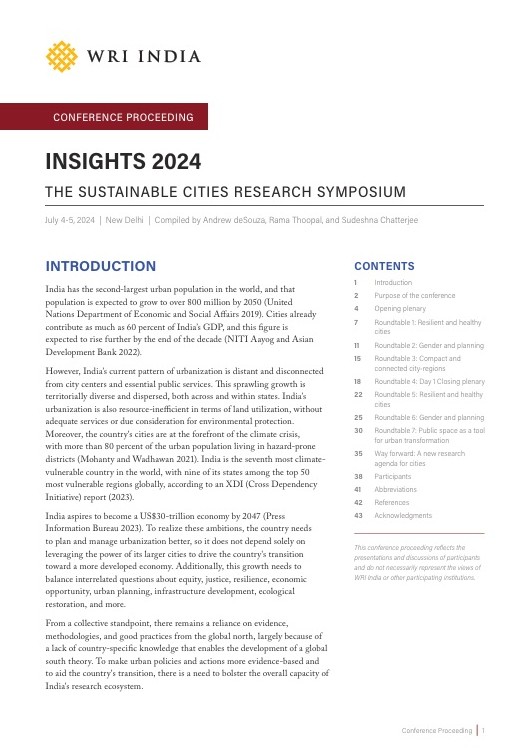Making Innovative Bus Systems a Reality - Opportunities and Challenges in India
by e -Government agencies in India are beginning to adopt open innovation as a means to identify innovative technologies and solutions to improve public services. Open innovation refers to partnerships between companies, individuals and public agencies to create innovative products and services and in the process, share its risks and rewards. It is a process borrowed from the private sector and used to accelerate a company or organization’s internal innovation process and yield optimal solutions for a particular problem in a short timeframe.
In the Indian context, open innovation in public agencies such as the Sunrise Open Challenge Hackathon hosted by the Andhra Pradesh Government, are hackathons wherein innovators will customise their product or service to develop a solution for a specific problem statement announced by the agency. The Maharashtra Startup Week and the Bengaluru Innovation Challenge, by contrast, are promoting open innovation in the form of competitions, that may result in a potential on-ground pilot with or without financial support from the government agency. Innovation integration is gaining traction in all sectors including mobility, however the public transit sector has yet to catch up.
Why is innovation needed in public bus systems?
Private vehicles have become a de facto mobility choice in Indian cities leading to extreme congestion and poor air quality. While private vehicles are growing at an average rate of 11 percent over the last decade, the use of public transit is decreasing. The share of public transit in work trips has dropped to 18 percent due to poor accessibility, limited services, low service quality and outdated technology. Given the current scenario where transit agencies are facing technical and financial challenges to address these issues, there is an opportunity to close the public transit gap by leveraging the capacity for innovation offered by the mobility start-up ecosystem.
There is immense potential for the public and private sector to work together and adopt innovative solutions to transform our public bus systems. In the research leading up to the roll-out of the Better Bus Challenge (introduced in our earlier blogs) and WRI India’s observations on new mobility, we identified four major trends in innovative mobility products and services that bus agencies could leverage:
Data driven decision-making tools that make optimal use of transit data to facilitate decision making on bus operations to improve efficiency, reliability and cost-effectiveness.
Commuter experience enhancement solutions that use transit data to provide information on bus services to passengers and greater multi-modal integration to make public transit more user-friendly.
New service models that improve passenger comfort and accessibility by providing private on-demand or customized bus services that cater to specific customer groups or inadequately serviced zones.
Energy efficient product innovation that identifies new cost-effective technologies aimed to improve efficiency and reduce emissions.
Challenges on the road to innovation
Studies across the globe have emphasised that existing governmental frameworks and regulations are not conducive to innovation. International cases have identified asymmetric government initiatives, the lack of an innovation culture, and resistance to change as some of the barriers to the adoption of open innovation in public agencies. Recently, the Indian Government has rolled out regulatory reforms and over 50 schemes to focus on nurturing innovation. Despite these efforts, private enterprises and public transit agencies continue to face major challenges with regard to establishing successful partnerships for testing potential solutions.
Regulatory challenges
Regulations governing the procurement of goods and services in public transit agencies and the lack of a single window clearance system, present an unfavourable environment for young innovators and enterprises to engage with transit agencies. Even in agencies where innovations have been tested and their impact assessed, scaling is limited due to the stringent eligibility criteria imposed by the mandatory tendering process, i.e. minimum company turnover and experience, excluding proposals made by young enterprises.
Financial challenges
Public bus agencies across the country are financially stressed, which inhibits their ability to procure buses and improve services in line with the existing and forecasted demand for public transport in cities. While schemes such as Jawaharlal Nehru National Urban Renewal Mission and Atal Mission for Rejuvenation and Urban Transformation provide for such improvements, there is no dedicated financial support to explore, test and scale innovative products and services. This has resulted in a lack of financial resources at the behest of the transit agency for adopting innovative products and services.
Institutional challenges
As per their mandate, the man focus of transit agencies is to provide bus services. This compounded with their operational stress, results in limited bandwidth to dedicate technical resources towards research and development of innovative services and products. Innovation integration, a relatively new concept, will require dedicated and trained resources to identify the need and role of innovation to improve existing bus systems.
Public transit in India can benefit from open innovation and its potential to transform city bus systems, however, the above-mentioned issues will need to be addressed. In this blog series, we will shed greater light on the extent of these challenges and attempt to narrow down potential solutions based on expert opinion and experiences gathered during the implementation of the Better Bus Challenge pilots.


